

Every pilgrim to Sabarimala has to follow the practices (vratam) for 41 days. Mandala Vritham starts of by wearing beads (mala) made of “Mandara drumam” or “Rudrasham” or “Palungu” with a locket of Sri Ayyappa or a bell. The ritual is usually done in any Hindu temple in the presence of a “Guru swamy”. Though this function can be performed on any day, Saturday or Uthram day is considered as the most holy day for this “malayidil.
From the time a devotee wear an Ayyappa mala, he is called an Ayyappan and has to follow a holy life. He should be a vegetarian and practice abstinence during the vritham period.
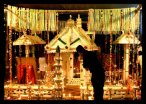
Every year the entire Vrischikam and part of Dhanu months are considered to be the holy 41 days of Mandalakalam. In these days special poojas are conducted in the temple especially for Lord Ayyapan. Ayyappan Vilakku is conducted on the first Saturday of Vrischikam. The whole night rituals & poojas are conducted in a specially constructed and decorated mandapam. Special poojas are conducted for Lord Ayyappan. Traditional Ayyappan Pattu (keertanams) is an integral part of the Vilakku. The whole poojas are conducted in traditional style without compromise on any of its aspects.
Thiri Uzhichil is also performed as one of the items in Ayyappan Vilakku festival. This item is performed early morning after the Ayappa Jananam (Birth of Ayyappa) ritual and the Paal kindi ezhunnallippu (ritual procession of Ayyappa bringing tigress’ milk)
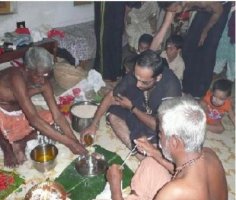
This ritual is the preparation and packing of “Erumudi kettu” for Sabarimala pilgrimage. It is prepared under the guidance of a guru swamy Only those who carry the Irumudikettu on the head would be allowed to climb the 18 sacred steps to the temple, as they are the ones considered to have observed the austerities and thus eligible to climb the holy steps. Other devotees have to resort to a different passage to reach in front of the sanctum sanctorum for worship.
During the Kettunira, after the initial prayers, the sacred offering of ghee (clarified cow’s butter) is filled inside a coconut, the fibrous covering of which is removed. The draining of the water within the coconut through a small hole on the top and filling it with ghee is a symbolic act. It signifies the draining out of worldly attachments from the mind and filling it with spiritual aspirations. Coconut is called “Thenga” in Malayalam and now the ghee-filled coconut, an offering for Lord Ayyappa, is known as the Nei-thenga. First, the first compartment of the bag will be filled-in with the Nei-thenga and other sacred offerings to Lord Ayyappa and the accompanying Deities. The front compartment is now closed by tying it with a string. The filled in front compartment is believed to be vibrant with spiritual power. Then the other compartment is filled with a few coconuts to be broken at various holy spots.
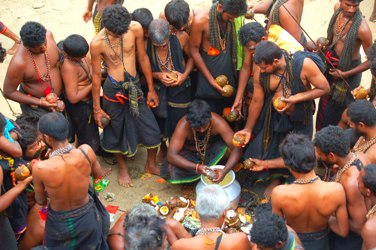
Neyyabhishekam is the most important offering to Lord Ayyappa. The ghee filled coconut is used to perform this ritual. The ritual starts at 4 AM and continue till Ucha Pooja(1PM).After performing the darsan of Lord Ayyappa and upa-prathistas, the group of Ayyappa pilgrim will make a Viri under the leadership of Guruswamy. They collect all ghee filled coconut and arrange in the viri. After taking bath at Bhasmakula, the team leader, usually a Guruswamy will break all ghee filled coconuts and collect the ghee in a vessel to offer it at the Srikovil.The priest after performing the Neyyabhishekam will return a portion of the ghee back to the devotee. The ghee obtained from the Srikovil is taken back as a divine prasadam. For devotees who don’t bring ghee filled coconut, Devaswom board has arranged facility to get “Adiyashistam neyyu”. After the Neyabhishekam, one portion of Neythenga (The ghee filled coconut) is offered to Kannimoola Ganapathy through the Homagni (fire of Ganapathi)
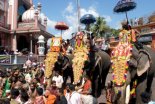
Petta thulal at Erumeli is an important ritual in the pilgrimage. It is performed in line with the dancing that Lord Ayyappa performed after eradicating Mahishi. It is believed that this thullal will clear the pilgrim Ayyappa from all sins. It clears the body and mind and provide the pilgrim the physical fitness for the daunting, lengthy pilgrimage through the forest.
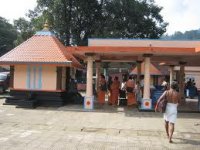
Pampa is the most important place in the pilgrimage. The pilgrims has to perform the following rituals at Pampa